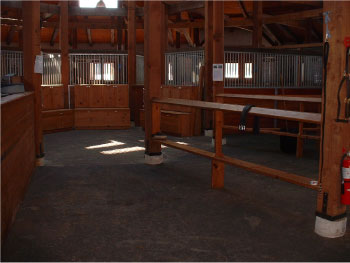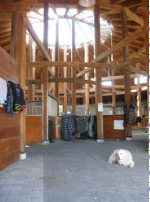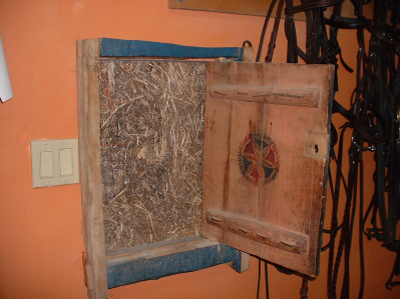ARCHIVE EQUINE NEWS STORIES
| Current news is available at TheHorsePortal.ca, Equine Guelph's online learning platform for practical, quick learning. Given the vast amount of information on horse health and welfare, Equine Guelph has archived its past news articles from 2002-2020. They are listed below, along with a search function available to find specific healthcare topics. | |
Environmental Stewardship: WELCOME TO HOP HILL STABLEJuly 2010
By Nadine Abrams
Ever thought about what you could do on your farm to reduce your environmental footprint? Recently, we took a look at Hop Hill Stables, located in the headwaters of the Pefferlaw River on the Oak Ridges Moraine, Uxbridge. This private boarding stable practices many environmental stewardship techniques thus, maintaining a naturally beautiful property while significantly reducing the environmental footprint or hoofprint as we say in the equine business.
Hop Hill Stable is owned and operated by Michael Jewett and his family. Mr. Jewett’s efforts in the protection of the environment and natural habitat are visible throughout the property. From fostering a healthy, diverse forest community, planting the areas along his creek with native vegetation, to innovative building enhancement projects, Hop Hill Stable is an excellent example for stewardship of both the natural and built environments.
His environmental ethic and unique building philosophy has focused on minimizing environmental impact and maximizing the property’s buildings and their overall function. Where possible, the building materials used in each project are salvaged to limit what goes into landfills. “This also reduces the need to purchase new materials from natural resources that would need to be harvested and processed, which further reduces our environmental footprint”, says Jewett.
 His vision began with the construction of a hexagon-shaped strawbale horse barn, which currently houses twenty horses. The rafters, stall posts and beams of the building’s structure were salvaged Douglas fir from the Joseph Seagram Distillery buildings in Waterloo. The structural posts and the walls of the adjacent building containing the tack area, as well as, an apartment are made from the barrel racking rails that originally held the whiskey barrels in the same Seagram building. The wainscoting along the passageway from the stable to the arena was also planed from the same wood. The Douglas fir stall planks were made from floor joists from an old Toronto office building, now the site of a new condominium. These were de-nailed and planed on one side to provide a smooth exterior surface for the stalls.
His vision began with the construction of a hexagon-shaped strawbale horse barn, which currently houses twenty horses. The rafters, stall posts and beams of the building’s structure were salvaged Douglas fir from the Joseph Seagram Distillery buildings in Waterloo. The structural posts and the walls of the adjacent building containing the tack area, as well as, an apartment are made from the barrel racking rails that originally held the whiskey barrels in the same Seagram building. The wainscoting along the passageway from the stable to the arena was also planed from the same wood. The Douglas fir stall planks were made from floor joists from an old Toronto office building, now the site of a new condominium. These were de-nailed and planed on one side to provide a smooth exterior surface for the stalls.
Mr. Jewett, although partial to salvaged wood for its structural integrity and ability to be modified, does not discount other materials when updating his buildings. In 2004, the Thorncrest Mall in Thornhill, Ontario was demolished, and a 7 metre diametre (24 foot) aluminum framed hexagonal skylight got a new life in the Hop Hill stable roof. It was removed from the Thornhill site, pane by pane, transported, hoisted by crane to its final destination and reassembled, providing a brilliant natural source of light to the structure.
 Although construction of this stable generally followed Jewett’s original vision and design plans, changes were inevitable during the process. This he says was not always easy for the tradesmen and suppliers. “The skylight for example, was not part of the original design and the roof aperture was a bit smaller than the skylight. When you look at it today, it simply gives the building its unique character, and does not look like an afterthought at all,” he says.
Although construction of this stable generally followed Jewett’s original vision and design plans, changes were inevitable during the process. This he says was not always easy for the tradesmen and suppliers. “The skylight for example, was not part of the original design and the roof aperture was a bit smaller than the skylight. When you look at it today, it simply gives the building its unique character, and does not look like an afterthought at all,” he says.
No stone is left unturned when it comes to Jewett’s practice of the 3 R’s (reduce, reuse and recycle). The interior of the walls of the barn are constructed from unused straw bales. “This material is so compressed it can support the weight of the roof structure, provide a very high R factor and is not combustible,” he adds.  The arena boasts a number of other finds from demolition activities at the Toronto International Airport and one of the General Motors plants in Oshawa.
The arena boasts a number of other finds from demolition activities at the Toronto International Airport and one of the General Motors plants in Oshawa.
Given the location of Hop Hill Stable on the Oak Ridges Moraine, it should come as no surprise that Jewett takes the concept of recycling one step further. The 20,000ft 2 arena roof drains through 10 downspouts into a 5,000 gallon cistern. This captured water is recycled, providing water for fire-fighting, washing, toilet flushing and irrigation. Mr. Jewett’s vision does not see their precious well water used for anything other than drinking. “The ground water here is some of the best in the world, and we don’t waste it or replace it with bottled water when we offer better from our own taps!” he adds. Capturing rainwater for other uses just makes sense. It eventually gets back into the moraine to recharge what he refers to as the “Rainbarrel of Southern Ontario.”
This is part one of a three part series on Hop Hill Stable. Stay tuned for part two which will discuss the circular paddock design, barn heating and construction of the hay storage building.
Contact your local Conservation Authority as they may be able to provide further funding and technical assistance for your environmental project. Not sure which of the 36 Conservation Authorities you should contact, check out the provincial map and contact listing on the Conservation Ontario website.
This article has been prepared by the Healthy Lands for Healthy Horses Steering Committee, which is comprised of representatives from the Ontario Equestrian Federation’s Horse Facilities Council, Uxbridge Horseman’s Association, Ontario Trail Riders Association, Equine Guelph, University of Guelph, Ontario Ministry of Agriculture, Food and Rural Affairs and various Conservation Authorities. Funding for events organized by this committee has been provided by the Ontario Soil and Crop Improvement Association from the Nutrient Management BMP Demonstration Grant funding project.
For more information please visit: www.equineguelph.ca/healthylands.php